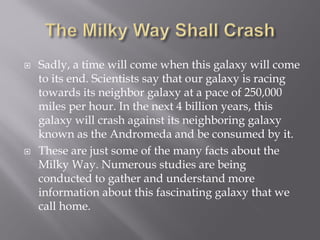Milky way galaxy
- 3. The Milky Way galaxy is home to our solar system. The sun and all the planets around it are just a fraction of what is known to the world as the Milky Way galaxy. This galaxy measures between 120,000-180,000 light years. Let’s take a look at some interesting facts about the Milky Way Galaxy.
- 4. Counting stars in a galaxy is a difficult job. For years, astronomers have been arguing about the best way to count stars and have not reached a conclusive finding. The telescopes can only see the stars that shine the brightest, but some stars are hidden behind dust and gases. According to a satellite of the European Space agency, there are one billion stars in the Milky Way. However, scientists believe that this number is just one percent of the actual number of stars. Keeping this belief in view, there are approximately a 100 billion stars in the Milky Way Galaxy.
- 5. Astronomers still do not know how much this galaxy weighs. Some estimates suggest that the weight of this galaxy is between 700 billion to 2 trillion times the mass of the sun. More than 80% of Milky Way’s mass is dark matter. Being dark in color, it cannot be observed directly. In a study conducted by University of Arizona, the mass of the Milky Way was estimated to be more than 900 billion times the mass of the sun.
- 6. In the 16th century, a Portuguese explorer named Ferdinand Magellan sailed through the southern hemisphere. According to a European observatory, Magellan and his crew were the first group of individuals who noticed circular clusters of stars in the night sky. These clusters aren’t mere groups of stars but small galaxies also known as dwarf galaxies. They revolve around the Milky Way and sometimes even collide with it.
- 7. Approximately 300 billion stars and about 100 billion planets are believed to be in the Milky Way galaxy. The Milky Way may also contains a billion neutron stars, about ten billion white dwarfs and a hundred million black holes. Interstellar medium, which is a disk of gas and dust fills the space between the stars. According to a recent study, grease like substances account for more than a quarter of the interstellar carbon in the Milky Way. The carbon present in the Milky Way suggests that there is life in other star systems.
- 8. Sadly, a time will come when this galaxy will come to its end. Scientists say that our galaxy is racing towards its neighbor galaxy at a pace of 250,000 miles per hour. In the next 4 billion years, this galaxy will crash against its neighboring galaxy known as the Andromeda and be consumed by it. These are just some of the many facts about the Milky Way. Numerous studies are being conducted to gather and understand more information about this fascinating galaxy that we call home.
- 9. Amita Vadlamudi is an Astronomy enthusiast. Ms. Vadlamudi has written many articles on the subject of Astronomy on several of her web sites. Following are a few examples: Amita Vadlamudi on Slideshare: https://www.slideshare.net/amitavadlamudi/jupiter-the- largest-planet-in-the-solar-system https://www.slideshare.net/amitavadlamudi/mars-our- neighbor-red-planet https://www.slideshare.net/amitavadlamudi/an- exploration-of-the-comet https://www.slideshare.net/amitavadlamudi/solar- systems-most-enigmatic-planet-saturn








